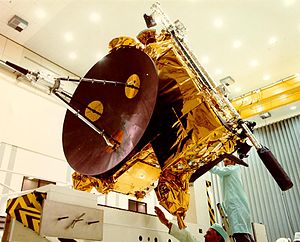
Back يوليوس (مسبار فضائي) Arabic Уліс (касмічны апарат) Byelorussian Одисей (мисия) Bulgarian Ulysses (sonda) Catalan Ulysses (sonda) Czech Ulysses (rumsonde) Danish Ulysses (Raumsonde) German Ulysses (sonda espacial) Spanish Ulysses (zunda) Basque کاوشگر فضایی اولیس Persian
 Ulysses spacecraft | |
| Names | Odysseus |
|---|---|
| Mission type | Heliophysics |
| Operator | NASA / ESA |
| COSPAR ID | 1990-090B |
| SATCAT no. | 20842 |
| Website | NASA Page ESA Page |
| Mission duration | 18 years, 8 months, 24 days[1] |
| Spacecraft properties | |
| Manufacturer | Astrium GmbH, Friedrichshafen (formerly Dornier Systems) |
| Launch mass | 371 kg (818 lb)[2] |
| Payload mass | 55 kg (121 lb) |
| Dimensions | 3.2 m × 3.3 m × 2.1 m (10.5 ft × 10.8 ft × 6.9 ft) |
| Power | 285 watts |
| Start of mission | |
| Launch date | 6 October 1990, 11:47:16 UTC[2] |
| Rocket | Space Shuttle Discovery (STS-41) with Inertial Upper Stage and PAM-S |
| Launch site | Kennedy Space Center, LC-39B |
| Contractor | NASA |
| End of mission | |
| Disposal | Decommissioned |
| Deactivated | 30 June 2009 |
| Orbital parameters | |
| Reference system | Heliocentric orbit |
| Perihelion altitude | 1.35 AU |
| Aphelion altitude | 5.40 AU |
| Inclination | 79.11° |
| Period | 2,264.26 days (6.2 years) |
| Flyby of Jupiter (gravity assist) | |
| Closest approach | 8 February 1992 |
| Distance | 440,439 km (6.3 Jupiter radii) |
 Ulysses mission patch | |
Ulysses (/juːˈlɪsiːz/ yoo-LISS-eez, UK also /ˈjuːlɪsiːz/ YOO-liss-eez) was a robotic space probe whose primary mission was to orbit the Sun and study it at all latitudes. It was launched in 1990 and made three "fast latitude scans" of the Sun in 1994/1995, 2000/2001, and 2007/2008. In addition, the probe studied several comets. Ulysses was a joint venture of the European Space Agency (ESA) and the United States' National Aeronautics and Space Administration (NASA), under leadership of ESA with participation from Canada's National Research Council.[3] The last day for mission operations on Ulysses was 30 June 2009.[4][5]
To study the Sun at all latitudes, the probe needed to change its orbital inclination and leave the plane of the Solar System. To change the orbital inclination of a spacecraft to about 80° requires a large change in heliocentric velocity, the energy to achieve which far exceeded the capabilities of any launch vehicle. To reach the desired orbit around the Sun, the mission's planners chose a gravity assist maneuver around Jupiter, but this Jupiter encounter meant that Ulysses could not be powered by solar cells. The probe was powered instead by a General Purpose Heat Source Radioisotope Thermoelectric Generator (GPHS-RTG).[6]
The spacecraft was originally named Odysseus, because of its lengthy and indirect trajectory to study the solar poles. It was renamed Ulysses, the Latin translation of "Odysseus", at ESA's request in honor not only of Homer's mythological hero but also of Dante's character in the Inferno.[7] Ulysses was originally scheduled for launch in May 1986 aboard the Space Shuttle Challenger on STS-61-F. Due to the 28 January 1986 loss of Challenger, the launch of Ulysses was delayed until 6 October 1990 aboard Discovery (mission STS-41).
- ^ "Ulysses". NASA's Solar System Exploration website. Retrieved 25 September 2023.
- ^ a b "Ulysses". NASA's Solar System Exploration website. Retrieved 2 December 2022.
- ^ "Welcome to the HIA Ulysses Project". Herzberg Institute of Astrophysics. Archived from the original on 17 August 2011.
The Herzberg Institute of Astrophysics (HIA) of the National Research Council of Canada provided instrumentation and test equipment for the COsmic ray and Solar Particle INvestigation (COSPIN) on the Ulysses spacecraft. The COSPIN instrument consists of five sensors which measure energetic nucleons and electrons over a wide range of energies. This was the first participation by Canada in a deep-space interplanetary mission.
- ^ Cite error: The named reference
ESA Newswas invoked but never defined (see the help page). - ^ The odyssey concludes ... Archived February 24, 2012, at the Wayback Machine
- ^ https://rps.nasa.gov/missions/13/ulysses/
- ^ "Inferno of Ulysses' urge to explore an uninhabited world behind the Sun. In Jane's Spaceflight Directory 1988, ISBN 0-7106-0860-8
© MMXXIII Rich X Search. We shall prevail. All rights reserved. Rich X Search